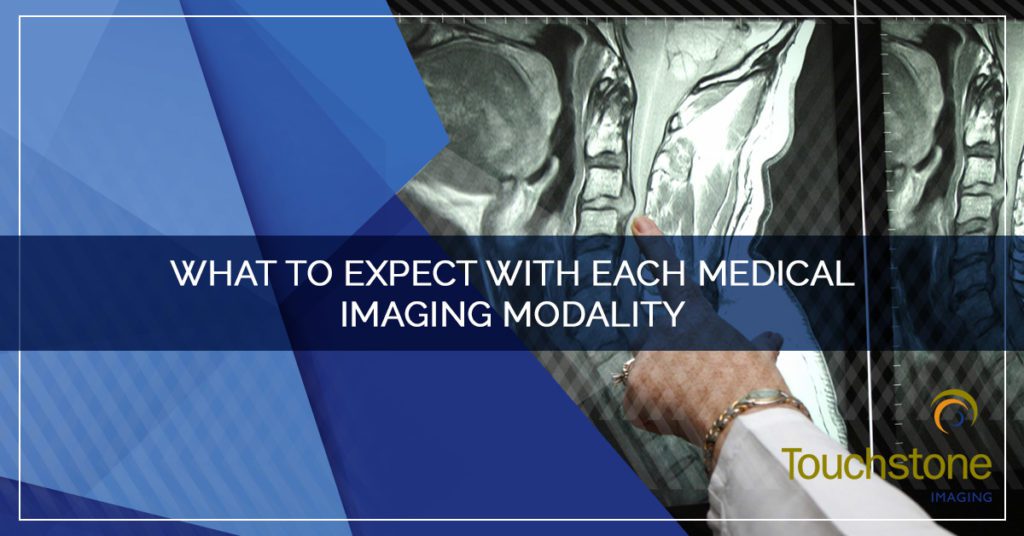In the field of medical imaging we all have a basic understanding of what a CT scan and MRI are, but do you know why the tests are being ordered by your healthcare practitioner? In today’s post, we’ll delve into medical imaging diagnostics and why they’re performed, how they work, and the potential risks involved with each one.
If medical imaging such as an x-ray, MRI, or CT scan has been ordered for your health, Touchstone Imaging is the industry leader in medical imaging and we stand by our promise that a machine will only ever be as good as the person running it. We specialize in medical imaging, but it is our team members that make our services stand out. We commit to individualized care in a space that is comfortable and where the care is exceptional. Follow today’s post as we explore the different medical imaging modalities.
Medical Imaging Tests – What to Expect
If a medical imaging test has been ordered and you are curious as to why, we’ll address basic diagnostic tests here to help assist in a better understanding.
- X-ray – An x-ray is used to diagnose dental concerns such as cavities and decay, broken bones, and lung concerns. They are also used to diagnose breast cancer (a mammogram is a specific type of x-ray), digestive issues, and heart failure. X-rays function by passing radiation through the body with the ability to form images of bones and dense structures. Soft structures will appear dark, while dense material will show up white for better detection. Some x-rays use dye mediums such as barium and iodine to make the organs more detectable. A small bit of radiation is emitted during an x-ray and allergic reactions are possible if someone ingests the contrast dye produces swelling, itching, and light-headedness.
 Computed Tomography (CT) – A CT scan is ordered and performed to help diagnose lung and bone health concerns such as pneumonia and fractures. They can also be employed to identify and monitor cancer. CT scans work by scanning your body at different angles and taking x-ray images at various points. A computer then configures the images to provide a cross-sectional image. Because a CT scan involves multiple x-ray images, the radiation amount is greater than what you would receive in a standard x-ray.
Computed Tomography (CT) – A CT scan is ordered and performed to help diagnose lung and bone health concerns such as pneumonia and fractures. They can also be employed to identify and monitor cancer. CT scans work by scanning your body at different angles and taking x-ray images at various points. A computer then configures the images to provide a cross-sectional image. Because a CT scan involves multiple x-ray images, the radiation amount is greater than what you would receive in a standard x-ray.- 4D CT – A 4D CT is an advanced CT scan that is more detailed and accurate that is better equipped to diagnose cancer, fractures, and lung issues. Like an x-ray and CT, it uses small amounts of radiation.
- Magnetic Resonance Imaging (MRI) – An MRI assists in diagnosing a myriad of health issues such as multiple sclerosis, cancer, stroke, heart conditions, tumors, bone, and joint concerns. The imaging test works by using magnetic fields combined with a computer to create very detailed, cross-sectional pictures of tissues and organs in the body. An MRI is radiation-free but can impact electronics accessories such as a defibrillator or a pacemaker. They also have the ability to pull metal objects from your body, so removing piercings is imperative.
- Ultrasound – An ultrasound help evaluates lumps, fetuses and tumors, infection, cancer, and to assess blood flow throughout the body, and it functions by emitting high-frequency sound waves that allow an image of structures in your body to form. This imaging protocol is also radiation-free and imparts sound waves.
- Bone Density (DEXA) – A DEXA scan is used to detect bone loss and diagnose bone issues such as osteoporosis and fracture risks. This noninvasive imaging exposes s small portion of the bone to ionizing radiation that produces images that give a glimpse within the bones. Since the DEXA is an x-ray it does emit radiation, in a small amount.
- Arthrography – This type of diagnostic imaging is used to help diagnose unexplained pain and joint issues within the tendons, ligaments, and cartilage. The method can be direct with contrast being injected straight into the site or indirect and introduced into the bloodstream. This type of imaging is paired with a CT scan or MRI, so it can either have radiation (CT) or be radiation-free MRI).
The different modalities of medical imaging, on one hand, are easy to understand on a basic level, it’s explaining them and knowing which ones are driven by radiation is where puzzled faces surface! In today’s post we’ve explored radiation-driven medical imaging that include:
- X-ray
- CT
- 4D CT
- DEXA
- Arthrography (both radiation and radiation-free)
Radiation-free medical imaging procedures include:
- MRI
- Ultrasound
- Arthrography
Medical imaging for your health
With a little background information on medical imaging techniques, you now can better understand why the procedure was ordered by your doctor, how it works, and the risks that are involved.
For the finest patient care from the little things such as scheduling and prompt services to comfortable scanning and accurate reports, Touchstone Imaging services support you with over 25 years of skilled and compassionate care. To schedule an appointment, contact us today!


